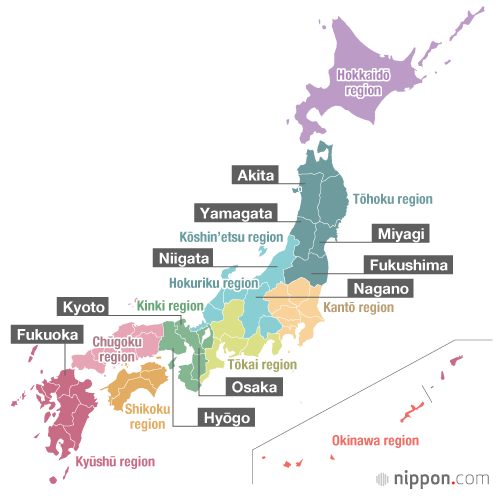
Sake Regions of Japan: A Journey Through the Land of Rice Wine
Share
Japan, a land steeped in history, culture, and natural beauty, is also home to an incredible variety of sake-producing regions, each with its own unique characteristics, techniques, and flavors. As you explore the world of sake, it's essential to take a virtual journey through Japan's diverse sake regions, understanding the terroir, rice varieties, and brewing traditions that make each area's sake distinct and memorable. In this blog post, we'll guide you through some of Japan's most renowned sake regions, from the snow-capped mountains of Niigata to the serene shores of Hiroshima.
- Niigata: The Land of Elegant Sake
Niigata Prefecture, located on the western coast of Japan's Honshu Island, is renowned for its pristine natural environment and heavy snowfall, which provide ideal conditions for producing high-quality sake. The region's clean, abundant water sources and highly polished, locally-grown rice give rise to a distinct style of sake known for its elegant, clean, and crisp flavors. Niigata is also home to the "Tanrei Karakuchi" style, a term used to describe sake that is both light and dry.
- Kyoto: A Tradition of Finesse and Refinement
Kyoto, Japan's ancient capital and the heart of its cultural heritage, is also home to the esteemed sake-producing region of Fushimi. With a history of sake production dating back over a thousand years, Fushimi is famous for its soft, pure water, which is sourced from underground springs fed by the surrounding mountains. This high-quality water lends a delicate, refined character to Fushimi sake, which is often described as having a silky, smooth texture and subtle, nuanced flavors.
- Hiroshima: The Birthplace of Ginjo
Hiroshima Prefecture, situated in western Japan, boasts a rich sake tradition, with a particular focus on the premium ginjo style. Hiroshima is the birthplace of the ginjo brewing technique, which involves using highly polished rice and precise temperature control during fermentation to create a refined, aromatic, and complex sake. The region's mild climate and soft, mineral-rich water contribute to the unique character of Hiroshima sake, which is known for its balance, depth, and fruity notes.
- Akita: A Celebration of Hearty Flavors
Located in the northern Tohoku region of Japan, Akita Prefecture is known for its heavy snowfall, long winters, and deep, rich sake. The region's cold climate and abundant water sources create the ideal conditions for brewing full-bodied, flavorful sake. Akita's signature sake style is characterized by its bold, robust flavors, with a focus on umami and a satisfying, lingering finish.
- Yamagata: A Symphony of Fruit and Floral Aromas
Nestled in the mountainous terrain of northern Japan, Yamagata Prefecture is renowned for its vibrant sake culture and dedication to quality. The region's pure water, fertile soil, and carefully cultivated rice varieties give rise to a diverse range of sake styles, with a particular emphasis on fruity and floral aromas. Yamagata sake is often characterized by its harmonious balance, lively acidity, and fresh, aromatic profile.
As you explore the world of sake, it's essential to appreciate the diverse sake regions of Japan and the unique characteristics, flavors, and traditions that make each area's rice wine distinct and memorable. By understanding the terroir, rice varieties, and brewing techniques of Japan's sake regions, you'll embark on a fascinating journey through the land of rice wine, unlocking the secrets and delights of this extraordinary beverage. Cheers, or as they, Kanpai!
